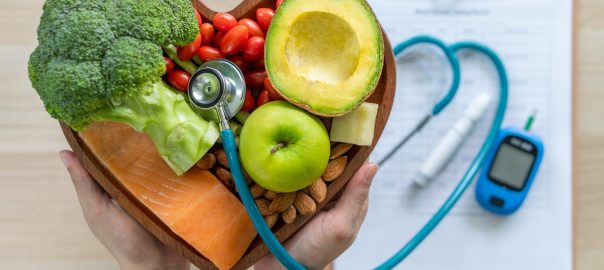
The Low Carb Diet for People with Diabetes
Dieting Tips for People with Diabetes
A 2020 report from Diabetes Canada suggests that a low carb diet can help manage blood sugar levels and support weight loss for people with type 1 and type 2 diabetes.
Over 11 million Canadians live with either diabetes or prediabetes. Organizations like Diabetes Canada have played a big role in supporting Canadians and providing knowledge and resources to manage these conditions. In this 2020 Diabetes Canada article, the Canadian Journal of Diabetes released an official statement endorsing a low carb (<130g of carbs/day) or very low carb (<50g carbs a day) diet to those with type 1 and type 2 diabetes. The benefits of these diets include better weight management and improved blood sugar control.
In this article, we break down the details of how a low carb lifestyle is beneficial for those managing diabetes or prediabetes and how to start a low carb diet. Always speak to your physician first to determine the right lifestyle choices for you.
What Characterizes Diabetes and Prediabetes?
Diabetes is a condition in which the body either cannot produce or properly use a hormone called insulin. Insulin is involved in processing sugar (glucose) from carbohydrates that we consume in our diet. It helps stabilize our blood sugar levels by signalling to the liver and muscles when to take in glucose and use it as energy, rather than storing it elsewhere in the body. When our blood sugar levels become too high (hyperglycemia) or too low (hypoglycemia) due to insulin malfunction, our bodies are thrown out of balance and we can experience a host of physical symptoms ranging from mild to severe. In the more severe and persistent cases, we see people develop insulin resistance (the body doesn’t respond to insulin anymore) which can lead to type 2 diabetes. In the case of type 1 diabetes, the body naturally produces little to no insulin on its own, which can also lead to chronically high blood sugar levels.
Genetics, aging and ethnicity are some factors that may cause certain individuals to be more at risk for developing type 2 diabetes. However, other factors may include excess body weight (especially around the abdomen), a lack of exercise, smoking and even a lack of sleep can contribute to insulin resistance. Type 1 diabetes is less well-understood and can affect individuals for their entire lives. With lifestyle changes and certain medications, there are ways to manage both types of diabetes.
Signs of Insulin Resistance
The following symptoms may be signs of insulin resistance and prediabetes. If you notice these signs early enough, you may be in a better position to treat or prevent the onset of diabetes.
- Extreme thirst or hunger
- Persistent hunger after meals
- Frequent urination
- Tingling sensations in the hands or feet
- Feeling more tired than usual
- Frequent infections
- Blurred vision
In addition, if you currently have high blood pressure, low levels of HDL (“good”) cholesterol or high levels of triglycerides (a type of fat) in your blood, you may be at higher risk for developing prediabetes or diabetes.
You can have blood work conducted to test for evidence of insulin resistance and prediabetes. Sustained insulin resistance can lead to diabetes, so the earlier it can be managed, the better.
Health Consequences of Diabetes
It is extremely important to manage prediabetes and diabetes. Both type 1 and 2 diabetes can seriously affect the major organs in your body and these complications can be life-threatening.
Type 1 and type 2 diabetes have been linked to:
- Heart disease
- Stroke
- High blood pressure
- Kidney disease
- Nerve damage
- Vision problems or loss of vision
- Limb amputation due to infection
The Low Carb Lifestyle and Diabetes
Managing your carbohydrate intake is one way to help reduce the potential health complications associated with diabetes. When we consume carbohydrates, they get converted into a useable type of energy called glucose. Glucose is burned very quickly by the body and as such, it can cause quick energy spikes and crashes – each accompanied with changes in blood sugar levels. These drastic and rapid changes can eventually desensitize our body’s insulin response, eventually causing insulin resistance and increasing the risk of diabetes. For those wanting to stabilize their blood glucose levels, limiting the amount of carbs consumed in a day and eating balanced meals that contain protein, fibre and fat can be beneficial. These macronutrients are digested more slowly by the body and won’t cause rapid changes in blood sugar levels.
In the case of diabetes, it is very important to stabilize blood glucose levels. People with diabetes must consciously manage carbohydrate and/or sugar intake in order to lower blood sugar levels. This is precisely why a low carb diet has proven to show positive results. This lifestyle change is necessary in many cases, as it is the only way to properly manage these conditions, apart from medications.
How a Low Carb Diet Works
If we reduce the amount of carbs we eat in a day, we must resort to other forms of energy besides glucose. The other type of energy our body can use is ketones, which is a fancy word for burning fat energy.
A low carb diet places emphasis on consuming the most amount of calories from high quality fats, a moderate amount of calories from protein and a low to very low amount of calories from carbs. Another key component of this diet is fibre, which is a type of carbohydrate, but one that is not processed by the body the same way as sugar and other carbohydrates. Fibre does not cause spikes in blood sugar levels, and actually helps stabilize them since it allows for slower digestion. This is why fibre helps us stay full, which is also beneficial for managing our caloric intake during the day.
Low Carb Diet and Weight Management
Restricting carbohydrates from the diet forces the body to start burning excess stores of glucose and then start burning excess stores of fat. As stated earlier, having excess fat around the abdominal area may increase the risk of developing diabetes. A low carb diet can help with weight management, which in turn, can help manage diabetes. Of course, maintaining a healthy diet is just one component of weight loss. For those wanting to significantly change their body weight, regular physical exercise as well as stress management, getting enough sleep and drinking plenty of water are all important aspects that can help you lose weight quickly and safely.
How to Start a Low Carb Diet for Managing Diabetes
If you and your health care provider determine that a low carb diet may be the solution for you, then keep reading to learn how to get started!
- Aim to consume <130g of carbs a day.
To give some perspective, 1g of carbs typically equates to 4 calories. So, on a low carb (<130g of carbs a day) diet, you should be consuming less than 520 calories from carbohydrates. If you choose to embark on a very low carb (<50g of carbs a day) diet, then you should be consuming less than 200 calories from carbohydrates each day.
Here are a few examples of common high carb foods and their respective calories and carbohydrates (g) per serving:
| Food | Serving Size | Grams (g) from Carbs | Calories |
| Rice, cooked | 1 cup (158g) | 45g | 206 |
| Pasta, cooked | 1 cup (100g) | 25g | 131 |
| Bread, white | 1 slice (25g) | 12g | 75 |
| Breakfast cereal | 1 cup (81g) | 55g | 307 |
| Potatoes, white | 1 med. potato (200g) | 37g | 163 |
Things like fruit and starchy vegetables may also contain high levels of natural sugars, and dairy products or certain processed meats may contain hidden added sugars. These seemingly “healthy” or low carb foods might not be what you think, so be sure to check the nutrition facts labels or do some research beforehand. There are also several applications for smartphones or tablets, like My Fitness Pal, that tell you the macronutrient and caloric breakdown of different foods. You can either scan the barcode of packaged products or input the name of a food, for example “banana”, to find out its nutrition facts.
- Choose healthy carbohydrates.
In addition to the amount of carbs you eat, the type of carbohydrates you consume matters as they can affect your blood glucose levels differently. In general, a distinction is made between “simple” and “complex” carbs. Simple carbs include things like white sugar, white rice, pasta, white bread, potatoes, fruit juices, soda, sweetened breakfast cereals, pastries and baked goods. On the other hand, complex carbs include foods such as vegetables, beans and legumes, brown or wild rice and whole grains such as oats, barley, buckwheat, quinoa, rye and whole wheat. These tend to contain more fibre and are processed more slowly by the body, thus making them healthier options and better for maintaining blood glucose levels.
- Reduce your carbohydrate intake gradually.
Many people experience unpleasant physical side effects when they cut carbs from their diet all at once. These side effects can range anywhere from mild dizziness and fatigue to nausea, constipation, diarrhea, sleeplessness, muscle soreness and uncontrollable sugar cravings. Give your body an easier and smoother transition into a low carb diet by gradually reducing carbs until you reach your desired level.
- Limit your caffeine intake.
Caffeine can also affect blood sugar levels and lower insulin sensitivity. So, if you are already making other lifestyle changes, it might be a good idea to also reduce or eliminate sources of caffeine (coffee, tea, soda, chocolate) as well. It only takes about 200mg of caffeine, which is approximately 1 cup of coffee, to affect your blood sugar levels. Caffeine increases levels of stress hormones in the body, which can prevent the production of insulin. Since diabetics already do not produce enough or properly use insulin, it is wise to eliminate other substances that can block this any further. In addition, caffeine can take a toll on your sleep, which lowers your insulin sensitivity (increases resistance). Check out our article about how diet affects sleep quality and weight loss if you are interested in learning more on this topic.
- Find recipes and products that fit your needs, and PLAN!
Finally, doing a little research and planning can help a lot with starting a new diet or making drastic lifestyle changes. This is especially true when it comes to a low carb diet, as many people who are used to consuming high carb foods may struggle to find adequate replacements or substitutes for every meal.
Meal planning and prepping can help a lot with the confusion of starting a new diet and prevent impulse eating that can throw you off track. Always keep your pantry stocked with low carb snacks and keep a list of simple recipes that can make it easier when you are short on time or when hunger unexpectedly strikes.
Take some time before the start of the week to write out some meal ideas and shop for the necessary ingredients. The Low Carb Grocery offers a number of products and articles that can help with the transition into the low carb lifestyle. Try browsing our inventory and Low Carb Lifestyle Blogs to find your next inspiration!
Stay Connected
We hope that you enjoyed reading this article and found some motivation to consider a low carb diet if you are currently managing type 1 or type 2 diabetes. If you would like to share your thoughts or experiences, head over to our Facebook and Instagram pages. We also love to read our reviews on Google, so if you enjoyed an experience you had with The Low Carb Grocery, please take a minute to let us know here!
Subscribe to our Weekly Newsletters, too, for updates on the latest products and special sales!






